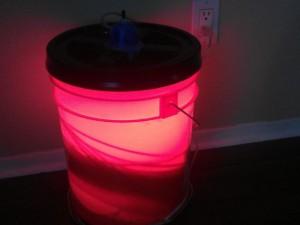Clinton Freeman of RepRage has some excellent advice for storing 3D printer PLA filament to avoid moisture problems.
Freeman is a Senior Software Engineer at NICTA in Brisbane Area, Australia, and he also worked for the State Library of Queensland and is a graduate of the University of Sydney.
He’s also a 3D printing aficionado, and he recently became interested in making a study of all the different ways people store PLA (polylactic acid) filament.
While there is no lack of available material being explored for 3D printing, by far the most common plastic materials are ABS and PLA. Both are thermoplastics, are excellent for formation into raw 3D printer feedstock, process well during 3D printing operations, and offer useful levels of strength, durability, and gloss.
Both ABS and PLA work most efficiently if they are sealed off from suffering the absorption of moisture from the surrounding environment. ABS can be dried using a source of hot, dry air, and though PLA can be dried, it may undergo alteration of the material’s crystallinity ratio and lead to unwanted changes in extrusion temperature characteristics.
In his investigation, he says he’s found a wide range of solutions that range from very simple to very elaborate PLA humidors.
“It was enough to spook me, and change the way I stored my stock of PLA filament,” Freeman says. “But I was still skeptical. I had more questions than answers. The first came up often: Absorb water? That doesn’t make sense. Isn’t PLA a plastic and waterproof?”
According to Freeman, experiments that examined how moisture and starch content affect PLA plastic were done by submerging PLA in stainless steel tubs filled with water for 30 days.
Before and after comparisons of the filaments following 30 days in water showed that they increased in weight by some 1-6% as the liquid was absorbed.
 Freeman says moisture damaged PLA can cause a variety of problems, two of them critical, in the process of 3D printing: it can damage the printer itself as swollen PLA filament can jam up the printer’s hot end and even require it to be replaced; and second, the moisture trapped inside the filament can turn to steam when a rapidly heated hot end creates unwanted pockets and bubbles within the finished object.
Freeman says moisture damaged PLA can cause a variety of problems, two of them critical, in the process of 3D printing: it can damage the printer itself as swollen PLA filament can jam up the printer’s hot end and even require it to be replaced; and second, the moisture trapped inside the filament can turn to steam when a rapidly heated hot end creates unwanted pockets and bubbles within the finished object.
The scientists also tested the strength of the prints which resulted from filament exposed to various levels of moisture and found that the more water absorbed by PLA, the weaker the objects became as a result. In fact, the filament stored for 30 days in water showed a reduction in the tensile strength of output objects by 6%, but once it was re-dried, the tensile strength of PLA fell 33%.
In his excellent article, Freeman offers a number of useful tips to make sure your PLA filament performs at peak efficiency.
Nylon filament can be adversely affected by moisture as well, and you can find a design for a filament dryer over at Instructables.
Have you got any advice for us on the proper ways to store and prevent moisture damage to 3D printing filament? Let us know in the 3D Printing Filament and Moisture Damage forum thread at 3DPB.com.
Subscribe to Our Email Newsletter
Stay up-to-date on all the latest news from the 3D printing industry and receive information and offers from third party vendors.
You May Also Like
Gorilla Sports GE’s First 3D Printed Titanium Cast
How do you help a gorilla with a broken arm? Sounds like the start of a bad joke a zookeeper might tell, but it’s an actual dilemma recently faced by...
Nylon 3D Printed Parts Made More Functional with Coatings & Colors
Parts 3D printed from polyamide (PA, Nylon) 12 using powder bed fusion (PBF) are a mainstay in the additive manufacturing (AM) industry. While post-finishing processes have improved the porosity of...
$25M to Back Sintavia’s Largest Expansion of Metal 3D Printing Capacity Since 2019
Sintavia, the digital manufacturing company specializing in mission-critical parts for strategic sectors, announced a $25 million investment to increase its production capacity, the largest expansion to its operations since 2019....
Velo3D Initiates Public Offering in a Bid to Strengthen Financial Foundations and Drive Future Growth
Velo3D (NYSE: VLD) has been among a number of publicly traded 3D printing firms that have attempted to weather the current macroeconomic climate. After posting a challenging financial report for 2023,...
































